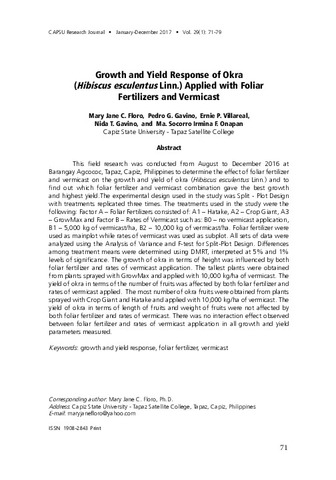Growth and yield response of okra (Hibiscus esculentus Linn.) applied with foliar fertilizers and vermicast

Associated content
researchjournal.capsu.edu.phDate
2017-01Metadata
Show full item recordScientific name
Geographic names
Abstract
This field research was conducted from August to December 2016 at Barangay Agcococ, Tapaz, Capiz, Philippines to determine the effect of foliar fertilizer and vermicast on the growth and yield of okra (Hibiscus esculentus Linn.) and to find out which foliar fertilizer and vermicast combination gave the best growth and highest yield.The experimental design used in the study was Split - Plot Design with treatments replicated three times. The treatments used in the study were the following: Factor A – Foliar Fertilizers consisted of: A1 – Hatake, A2 – Crop Giant, A3 – GrowMax and Factor B – Rates of Vermicast such as: B0 – no vermicast application, B1 – 5,000 kg of vermicast/ha, B2 – 10,000 kg of vermicast/ha. Foliar fertilizer were used as mainplot while rates of vermicast was used as subplot. All sets of data were analyzed using the Analysis of Variance and F-test for Split-Plot Design. Differences among treatment means were determined using DMRT, interpreted at 5% and 1% levels of significance. The growth of okra in terms of height was influenced by both foliar fertilizer and rates of vermicast application. The tallest plants were obtained from plants sprayed with GrowMax and applied with 10,000 kg/ha of vermicast. The yield of okra in terms of the number of fruits was affected by both foliar fertilizer and rates of vermicast applied. The most number of okra fruits were obtained from plants sprayed with Crop Giant and Hatake and applied with 10,000 kg/ha of vermicast. The yield of okra in terms of length of fruits and weight of fruits were not affected by both foliar fertilizer and rates of vermicast. There was no interaction effect observed between foliar fertilizer and rates of vermicast application in all growth and yield parameters measured.


